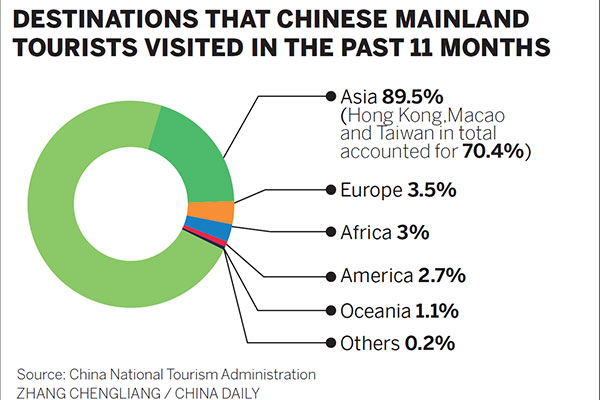
[Image/China Daily]
BEIJING — When the winter cold struck Beijing during the last week of November, Li Qin, a staffer at a Beijing-based foreign firm, took a weekend getaway with his wife to Thailand’s Koh Samui resort island.
The Chinese couple, like millions of other city dwellers in the mainland, has had a growing interest in overseas travel in recent years. According to official data released by tourism authorities, overseas trips by Chinese surpassed 100 million in the first 11 months of this year.
The number marked a historical record. In 1998, total overseas trips made by mainlanders stood at only 8.43 million. Since then, travel has expanded by more than tenfold.
“It’s a milestone in China’s tourism industry,” said Zhang Jilin, spokesman for the National Tourism Administration (NTA) at a press conference.
Asian countries and regions accounted for 89.5 percent of Chinese overseas travel destinations, followed by 3.5 percent to Europe, 3 percent to Africa, 2.7 percent to the Americas, and 1.1 percent to Oceania, according to NTA data.
Meanwhile, China’s Hong Kong, Macao and Taiwan accounted for 70.4 percent of total overseas trips from the mainland during the period.
Six countries — the Republic of Korea (ROK), Thailand, Japan, the United States, Vietnam and Singapore — received over one million Chinese tourists each during the first 11 months of the year.
President of China Tourism Academy Dai Bin said that surging travel to neighboring countries is due to cultural proximity, lower costs and convenient transport.
Dai predicted that the tourism market in neighboring countries will have even greater growth potential as a result of China’s diplomatically and strategically important Silk Road initiatives, which involve building a land-based belt from China via Central Asia and Russia to Europe, and a maritime Silk Road through the Straight of Malacca to India, the Middle East and East Africa.
“As China’s new diplomatic strategies and measures, the initiatives will boost cooperation in multiple fields such as politics, economy and culture. They are also poised to boost cross-border tourism,” Dai said.
Analysts said that even though faraway destinations such as America and Africa are attracting an increasing number of Chinese travelers, neighboring nations will still maintain an advantage due to proximity. The growing number of Chinese tourists has helped catapult tourism development in countries such as Vietnam and Cambodia since the Asian financial crisis.
In northeast Asia, Chinese tourists to the ROK and Japan surged more than 40 percent so far this year from a year ago, as the two nations seek to loosen travel policies to vie for more Chinese consumers, said Guo Dongjie, vice president of Ctrip.com, a leading online travel service provider.
Zhang Jilin said that increasing overseas travel demonstrates the progress in China’s social and economic development, as well as the success of China’s diplomatic policies, which stress friendship and mutual benefit with its neighbors.
The data also indicate that China’s neighboring countries and regions are an emerging source of tourists to the mainland.
Hong Kong, Macao and Taiwan accounted for nearly 80 percent of overseas tourists to the Chinese mainland, according to the data.
“Due to the same language and ethnicity, travel among the mainland and Hong Kong, Macao and Taiwan are the most robust in the Asia-Pacific,” said Li Shihong, director of the tourism promotion and international exchanges department under the NTA.
